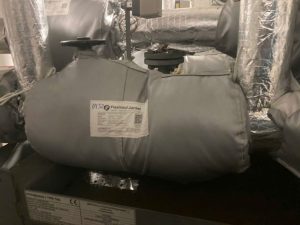What Are Flange Insulation Jackets and Why Are They Necessary?
In industrial piping systems, components like flanges, valves, and joints are often the biggest weak points for energy loss. Due to their complex shapes and the need for periodic inspection, they are frequently left uninsulated. Flange insulation jackets (also known as insulation blankets or removable insulation covers) were created to solve this problem completely. They are a flexible insulation solution designed to fit snugly around fittings, optimizing performance and ensuring safety.
The Serious Consequences of Neglecting Flange Insulation
Failing to insulate flanges and valves is not just a minor oversight; it leads to several serious consequences:
- Energy loss and soaring costs: Bare flanges act as “thermal bridges,” continuously leaking thermal energy (hot or cold) into the environment. This forces the system to work harder to compensate, leading to higher energy bills.
- Workplace safety hazards: The surface of a flange can reach extremely high temperatures (causing severe burns) or very low temperatures (causing cold burns and condensation that leads to slippery floors), creating a hazardous work environment for personnel.
- Impact on production efficiency: Unstable temperatures in the pipeline can degrade product quality and affect the efficiency of the entire production line.
- Corrosion and equipment damage: Water vapor condensing on the cold surface of a flange is a primary cause of Corrosion Under Insulation (CUI), significantly reducing the lifespan of pipes and fittings.
The Smart Construction of a Flange Insulation Jacket
Insulation jackets are designed with multiple layers of specialized materials to ensure superior thermal efficiency and durability. A typical construction includes:
- Outer Cover: Usually made from Silicone or Teflon (PTFE) coated fiberglass fabric, which is heat-resistant, water-repellent, UV-resistant, and chemical-resistant, protecting the inner layers from environmental factors.
- Core Insulation Layer: The “heart” of the insulation jacket, typically made of Ceramic Fiber, Rockwool, Glasswool, or Aerogel. The choice of material depends on the operating temperature range of the system.
- Inner Liner: The layer in direct contact with the equipment’s surface, often using fiberglass or stainless steel mesh fabric to withstand high temperatures and prevent corrosion.
- Fastening System: Uses high-temperature straps, industrial-grade Velcro, or stainless steel hooks, making installation and removal quick and easy without specialized tools.
Unmissable and Superior Benefits
Investing in flange insulation jackets provides a dual benefit in terms of economy and operational safety.
- Maximum Energy Savings: Reduces heat loss at connection points by over 90%, significantly lowering operating costs and offering a quick return on investment.
- Safety First: Keeps the outer surface temperature of the insulation jacket at a safe-to-touch level, completely eliminating the risk of burns to workers.
- Easy, Uninterrupted Maintenance: Can be removed and reinstalled in minutes, allowing for convenient inspection, bolt tightening, or maintenance of joints without destroying the insulation material like with permanent methods.
- Flexible and Reusable: Custom-made for each specific flange and valve size. The jackets can be reused many times throughout the equipment’s lifecycle, delivering long-term economic value.
- Comprehensive Equipment Protection: Prevents condensation, protects against corrosion, and extends the lifespan of pipes, flanges, and metal fittings.
Diverse Industrial Applications
Flange insulation jackets are an essential solution in many industries:
- Oil refineries, petrochemical and chemical plants
- Power plants, boilers, steam systems
- Food and beverage processing
- Pharmaceuticals, cleanrooms
- HVAC systems, Chiller pipelines
Considerations for Selecting and Installing Insulation Jackets
To achieve optimal performance, careful selection of insulation jackets is crucial:
- Accurate Measurements: Each insulation jacket should be fabricated based on a specific template for each type of flange or valve to ensure a snug fit and maximum insulation efficiency.
- Smart Design: Prioritize designs that include flaps for bolts, allowing for inspection and tightening of nuts without removing the entire jacket.
- Proper Installation: Ensure straps are tightened just enough for the jacket to fit snugly against the surface, leaving no gaps that could cause heat loss.
Equipping your connection points with insulation jackets is a smart investment that contributes to building a safer, more efficient, and sustainable plant operation.
Request consultation and quotation now!Frequently Asked Questions
What is a flange insulation jacket?
It is a type of thermal insulation cover designed for easy removal and installation, specifically for components like flanges, valves, and elbows on pipelines to prevent energy loss and ensure safety.
Why is it necessary to insulate flanges?
An uninsulated flange acts as a “thermal bridge” causing significant energy loss, posing a burn risk to personnel, and promoting equipment corrosion due to condensation.
What temperature can insulation jacket materials withstand?
Depending on the design, insulation jackets can withstand temperatures from deep cryogenic levels to over 1000°C. The insulation material is selected to match the specific operating temperature of the system.
Is it complicated to install an insulation jacket?
Not at all. Insulation jackets are designed with smart straps and fasteners, allowing one person to quickly install or remove them in minutes without any specialized tools.
Are insulation jackets reusable?
Yes. This is one of their biggest advantages. Insulation jackets are very durable and can be removed and reinstalled many times for maintenance purposes, providing long-term economic value.
Is the investment cost for insulation jackets high?
The initial cost may be higher than permanent insulation, but thanks to their superior energy savings and reusability, the payback period is often very short, and they provide greater long-term economic benefits.










